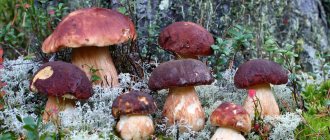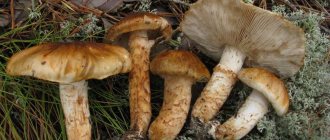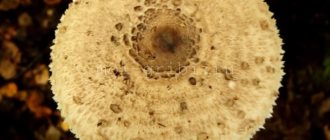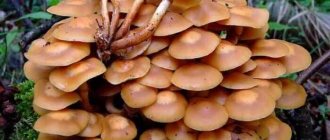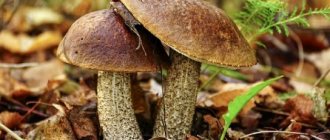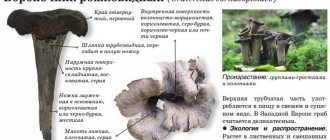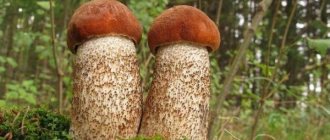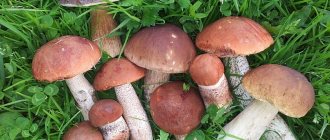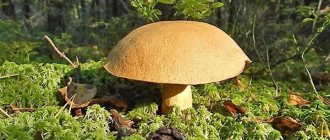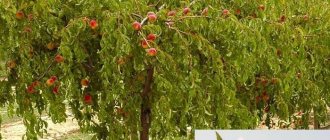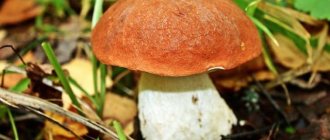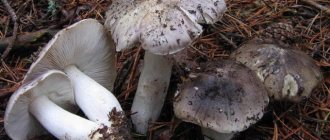Boletus mushrooms (boletus mushrooms)
Strong boletus mushrooms, close relatives of boletus mushrooms, belong to the genus Obabok and are considered mushrooms of excellent quality. As the name indicates, they are in symbiosis with birches, often developing under these trees. However, this does not always happen - various species can be found on the outskirts of swamps, in dry pine forests or in beech groves.
Main types
Common boletus (Leccinum scabrum)
Common boletus (Leccinum scabrum)
The best appearance of this group is characterized by a smooth hemispherical cap with a diameter of up to 15 cm. The skin is chestnut with a grayish, black or reddish tint; in young mushrooms it is light. The leg is up to 20 cm high, slender, wide at the base, the surface is dotted with a scaly dark pattern.
The pulp is grayish-white, then gray, does not darken when scrapped, first hard, then soft, porous. The structure is spongy in rainy weather. The taste is pleasant, the aroma is mushroom.
Swamp boletus (Leccinum holopus)
Swamp boletus (Leccinum holopus)
A tall mushroom with a very light, almost white convex cap up to 15 cm in diameter. The skin is thin, sometimes greenish or brown. The leg is long, thin, often curved, cap-colored or brownish. The tubes are whitish-cream, then brownish, turning green when pressed.
The pulp is creamy, later with a yellowish-green tint, does not darken when broken, watery, fresh in taste, with a slight mushroom aroma, often odorless.
Stiff boletus (Leccinum duriusculum)
Stiff boletus (Leccinum duriusculum)
The fleshy, robust species rarely becomes wormy, and is especially loved by mushroom pickers for this quality. The cap is up to 15 cm in diameter, hemispherical, then convex, concave in older specimens. The skin is first velvety, then smooth, matte, in wet weather - slippery, light chestnut, with a red tint, often with a lilac tint. The leg is up to 15 cm high, cylindrical, thickened in the center, cream-colored, covered with a mesh scaly pattern.
The tubes are creamy and turn greenish-brown where touched. The flesh is tight, white-cream, greenish-yellow at the stem, with a pink tint when the cap is broken, and greenish or blackened when cut at the stem itself. The taste is neutral, the aroma is pleasant, mushroom.
Boletus variegated (Leccinum variicolor)
Boletus variegated (Leccinum variicolor)
Externally and in culinary use, the species is similar to the common boletus. The cap is variegated - brown with whitish-gray spots and streaks, sometimes the main color is brown, almost black, reaches a diameter of 15 cm. The leg is brown, cylindrical, smooth, green at the base.
The tubular layer is dirty white with a bluish tint and darkens when pressed. The pulp is creamy white, when broken, it acquires a pink tint, and at the stem it turns red or green. The structure is watery, the taste is fresh, the smell is light, mushroom.
Pink boletus (Leccinum roseafractum)
Pink boletus (Leccinum roseafractum)
The hemispherical cap eventually becomes cushion-shaped and reaches a diameter of 12 cm. The skin is yellowish-brown or brown, often spotted, with light streaks. The leg is low - up to 10 cm, sometimes curved, the surface is light, with a black-brown scaly pattern.
The tubes are creamy and turn pink when pressed. The pulp is firm, light cream, turns pink when cut, and later becomes dark. The smell is insignificant, the taste is simple.
Gray boletus (hornbeam) (Leccinum carpini)
Gray boletus (hornbeam) (Leccinum carpini)
An appetizing mushroom with a round cap up to 15 cm in diameter, which is first hemispherical, then cushion-shaped, and later flat. The color of the skin is in brownish-gray tones - from light gray to brown, olive, black, yellowish in the center at the edges. The surface is velvety, at first wrinkled, then matte, cracked in hot weather, and slippery in damp weather.
The leg is tall - up to 16 cm, thick at the top, the surface is light, darkens when pressed, and is dotted with black scales, which later become brownish. The tubes are white, creamy-gray, and brown or purple when pressed.
The pulp is whitish with a yellow tone. When broken, it acquires a deep pink or red color, later turning black.
Black boletus (Leccinum melaneum)
Black boletus (Leccinum melaneum)
Squat appearance with a dark brown cap of hemispherical, then convex shape, up to 10 cm in diameter. The leg is up to 12 cm high, smooth, brown or grayish, abundantly dotted with darker scales. The skin is velvety, then matte, and sticky when damp.
The tubes are large, cream or grayish-white. The pulp is firm, white, and does not darken or turn slightly blue when cut. Mushroom aroma, neutral taste.
What time can I find it?
Redheads, depending on the species, bear fruit at different times.
- Spikelets do not grow abundantly. Their time is the end of June, the first week of July. At this time, yellow-brown and white boletuses bear fruit. They are the first of their brothers to appear in the forest.
- Reapers appear from mid-July and until August-September they delight with a bountiful harvest. This species includes black-scaled boletus, red boletus, and oak boletus.
- From mid-September you can meet deciduous plants in the forest. They are distinguished by a long fruiting period - they grow until the frosts of October. Redhead pine and spruce grow well until mid-autumn. This is explained by the fact that the pine needle bedding becomes a kind of blanket that protects the mycelium and grown mushrooms from the cold.
How to distinguish boletus from boletus?
Despite their eloquent names, these mushrooms, belonging to the same genus, can settle under aspens, and under birches, and under the canopy of many other trees.
Young mushrooms, especially light-colored species, are difficult to distinguish, and to more accurately determine the species, it is better to look for adult specimens. They are distinguished by the color of the skin, the structure and color of the pulp when broken.
In general the colors of boletus mushrooms are more modest, often in gray-brown or brown tones; boletus mushrooms are brighter - their caps are reddish-brown and orange-yellow. However, this difference is not always characteristic - the common boletus and the red boletus are similar in their chestnut-red caps, and both of these species can grow side by side.
An experienced mushroom picker will distinguish boletus by the structure of the pulp - it is more porous, loose, becomes watery with age and, when broken, does not darken or changes color slightly - often turning pink.
Boletus
Boletuses are characterized by tight flesh, which quickly turns color when cut - turns blue, purple or brown. The fruiting bodies are hard and are not destroyed by heat treatment, and therefore these species are often preferable to boletus mushrooms.
Both mushrooms are edible, have excellent quality and can be safely eaten - they are suitable for drying, pickling and any culinary delights.
Benefits and possible harm
Boletus and boletus, like other mushrooms, consist of 90% water. It also contains proteins, fiber, carbohydrates, minerals and fats.
- By including mushrooms in your diet, a person receives the following benefits:
- cleansing the body of toxins;
- improving the functioning of the central nervous system;
- reduction of kidney problems;
- normalization of blood sugar.
Mushrooms are also useful for the skin and mucous membranes of the body, and help in the treatment of problems of the musculoskeletal system. In terms of amino acid content, mushrooms are equal to meat, only they are less caloric and less digestible.
To get the maximum benefit from eating mushrooms, you need to follow the cooking technology: chop well, boil and fry the fruiting bodies. Allergy sufferers, elderly people, and patients with gastrointestinal and liver diseases should not eat them.
Important! A child’s body develops gradually, so you should not give mushrooms to children under three years of age.
There will be no benefit from this, and the child does not need any extra stress on the digestive organs. When going into the forest, arm yourself with a sharp knife to carefully cut off the fruiting bodies and not spoil the mycelium. After harvesting, process the mushrooms as quickly as possible. Choose your favorite recipe and delight yourself and your family with aromatic, tasty and healthy mushroom delicacies.
Places of distribution and time of collection
Various species are common in temperate climates, in deciduous forests and parks. They live in abundance under birch trees, and it is with this tree that the titular mycorrhiza forms, the common boletus . Tight fruiting bodies are found on the edges, clearings and along forest roads. The noble mushroom does not like acidic peat soils, preferring neutral loams or calcareous soils. The collection time is long - from the end of spring until the chilly autumn and the first frosts.
In swampy lowland forests, including on peat bogs, most often under birch trees, the mycelium of boletus . These fragile mushrooms appear in whole clearings, from July until the first frost.
In deciduous and deciduous-coniferous forests, under aspen and white poplar, you can find a rather rare mushroom, the severe boletus . It prefers calcareous soils and appears singly or in small families from July to mid-October.
On the sun-warmed edges and clearings of gloomy mossy forests, under birches and poplars, variegated caps of the multi-colored boletus . The species settles in small groups or singly; collection time is from July to early autumn.
Pink boletus is found in birch groves and mixed forests . More often it settles on the outskirts of swamps, on peat soils. This stable, but rather rare species forms mycorrhiza with birch and is distributed wherever this tree grows, right up to the tundra zone. The harvest takes a short period of time - from August to early October.
Mid-summer and early autumn is the time to collect black boletus mushrooms . Places of growth - damp lowlands of birch and mixed, most often birch-pine forests, the outskirts of swamps and clearings.
gray boletus or hornbeam grows in abundance . Fruiting bodies are collected in three waves: the first - during the flowering of rowan - in early summer; the second - in July, after haymaking; the third, autumn - in September-October.
Boletus: photo and description of the mushroom
Boletus is also called redhead and aspen. It belongs to the fungi of the genus Leccinum or Obabkom. Why is it called that? It owes its name to aspen, since its mycelium is closely related to this tree . It is in aspen forests that such mushrooms can most often be found, which is why it was called that. It is also called by this name because its cap is very similar to an autumn aspen leaf.
All types of mushroom have a brightly colored cap , a stocky stalk and a dense structure of the fruiting body. Depending on the type, the diameter of the cap can vary from 5 to 20 cm. Sometimes even thirty centimeters are found. Young mushrooms of various types of redheads usually “wear” a hemispherical cap that tightly squeezes the upper part of the stem. You can compare it to a thimble that is put on your finger. Growing up, the mushroom acquires a convex cap, similar to a pillow; as it ages, it straightens. The skin on the cap is usually dry, but sometimes velvety. In some species it hangs from the edges, in most it cannot be removed.
The leg is tall, sometimes reaching 22 cm; its distinctive feature is
a club-shaped shape with a thickening at the base.
Small brown or black scales can be seen on the surface. A porous layer 1 to 3 cm thick is visible under the cap
Redheads have smooth spindle-shaped spores. The powder obtained from them is olive-brown or ocher-brown. The flesh of the cap is elastic, fleshy, and has a dense structure. In the leg, the tissue fibers are arranged lengthwise. The boletus has white flesh , but if it is cut, then in this place it acquires a blue and then black color.
False species and doubles
Tubular mushrooms do not have such dangerous doubles as lamellar mushrooms. And yet, due to inexperience, the very poisonous pale grebe can be mistaken for a swamp boletus, and the real and pinkish species can be confused with a gall fungus.
Death cap
Death cap
In various deciduous forests - under birches, aspens, beeches, this most poisonous mushroom is found from July to October. The cap is first spherical, then flattened, glossy, light, sometimes with a greenish or olive tint, reaches a diameter of 10 cm. The leg is slender, without scales, with a cuff under the cap, the expanded base is hidden in a kind of pouch near the ground.
The whitish pulp is aromatic, fragile, and tastes sweet. Unlike tubular mushrooms, wide white plates are found under the cap. The species is very poisonous and even a small amount causes severe poisoning, and there is no antidote.
Bile mushroom
Bile mushroom
This species is not poisonous, but is not eaten due to its unpleasant, bitter, acrid taste. The cap is hemispherical, up to 15 cm in diameter. The skin is glossy, brownish or light chestnut. The leg is squat, thickened in the middle, with a dark mesh pattern at the top.
The pulp is very bitter, white, and turns pink when cut, reminiscent of pink boletus. In the latter, the tubular layer is creamy and turns pink only when pressed or at a break, while in the gall fungus the tubes are initially bright pink. Found in coniferous and coniferous-deciduous forests from mid-summer until frost.
Safety in the forest
As mentioned earlier, the forest is a high-danger zone; there is a risk of getting lost or getting into an unpleasant situation; to warn them, follow simple rules:
- Clothing should be comfortable and suitable for weather conditions.
- Raincoat - if you think it is necessary, then it is better to take it. An umbrella in this case is not very convenient, because... in your hands you will have a basket and a cane for searching for mushrooms.
- Shoes - It's best to wear comfortable and waterproof ones, especially if your run starts early in the morning, a lot of dew on the grass and leaves can make you uncomfortable.
- Navigation - during the search process, try to keep a path or some other landmark in your field of vision, you can use navigation on your phone, but cellular communications do not always work in the forest, as an option, take a GPS navigator with you, this device does not require cell towers, it keeps in touch with the satellite, but works well only in open areas, so in order to get your bearings, you need to go out into the open area before using it, so that there are no trees overhead.
- A basket or a bag - the best option is a basket; unlike a bag, the collected mushrooms will have access to air and be ventilated, as a result you will deliver them home fresh.
- Knife - for convenience and in order not to damage the mycelium, take it with you; the knife should be taken with a bright and visible handle so that it does not get lost in the grass.
- Have a snack - you can put a sandwich in your basket with you, or even better, a bar of chocolate, if hunger overtakes you during the hike, you will have something to answer it with.
- Be sure to take water with you, because... the feeling of thirst will definitely come; picking mushrooms is a very serious aerobic exercise.
- Mosquitoes and other game - to protect yourself from flying mosquitoes and ticks, be sure to take a cream or other means of protection.
- A search cane is a seemingly simple thing, but it can greatly simplify and secure your hikes in the forest. One of its functions is that you can push apart foliage or grass without bending over and identify the mushroom. And the second and most important thing is that various living creatures can be found in the forest, including... snakes, a cane will protect you from contact with them, since you won’t be pushing the grass apart with your hands!
Beneficial features
Nutritious boletus mushrooms in dried form are close in calorie content to bread and are significantly superior to many vegetables. But unlike carbohydrate or fatty, energy-rich foods, their calorie content is determined by the presence of proteins, which are a building block of the body and must be present in the diet.
The protein composition is characterized by the presence of essential amino acids - leucine, tyrosine, arginine and glutamine, which are in an easily accessible form and are quickly absorbed.
The pulp is rich in vitamins; thiamine, nicotinic and ascorbic acids, vitamins E and D are significantly present in it. A whole complex of essential microelements - calcium and phosphorus, sodium and potassium, manganese and iron complement this wonderful natural store of valuable substances.
The fibers contained in mushroom tissues stimulate intestinal function and have a beneficial effect on digestive processes. Preparations from dried mushrooms have long been used in folk medicine for urolithiasis and inflammatory diseases of the excretory system.
These mushrooms are known to act as antioxidants, which reduce the number of free radicals and thus reduce the risk of cancer, slow down the aging process, and strengthen the immune system.
Video about boletus mushrooms (boletus mushrooms)
Everyone was successful with boletus mushrooms - beautiful, nutritious, tasty mushrooms, famous for their productivity and long-term fruiting. A knowledgeable mushroom picker will never be left empty-handed and, after a mushroom rain, he will easily find the stout caps under birch, hornbeam or poplar trees, notice the sturdy ones peeking out from under the leaves in swampy lowlands and on the edges of light birch groves, and will definitely fill the basket with these fragrant gifts of nature.
Boletus and boletus are not species, but groups of species of the genus Obabok (Leccinium), and in general are very close to each other. Despite this, it is difficult to confuse them. Boletuses have a very characteristic bright orange cap (but one of the species, the white boletus, has an uncharacteristic white cap), a thick fleshy stem (sometimes in young mushrooms the stem is thicker than the cap), they quickly turn blue or even black when cut. The boletus, on the other hand, has a more modest gray-brown or black coloring of the cap, usually a thin stalk (but some boletus have a thick stalk - hornbeam, harsh boletus, black boletus), sometimes turns pink when cut (in the pink boletus), rarely turns blue (hornbeam). And they grow under birch trees (hornbeam - under hornbeam, but in the absence of one, it also grows under birch trees), and boletus - under poplars (including aspen). However, this is not a strict condition: all bastards can form mycorrhiza with almost any deciduous trees of our forests.
Oak boletus is a mushroom that can be called both boletus and boletus. But rather, it is neither one nor the other, since it grows under oak trees. But it is closely related to both. But in general it doesn’t matter - the mushroom is edible and good.
Contraindications
Healthy, tasty boletus mushrooms are among the best edible species, but dishes made from them should absolutely not be eaten by people suffering from gastritis, duodenal ulcers, hepatitis of any etiology, or inflammatory processes in the gallbladder.
Some people may experience individual intolerance, which is characterized by allergic reactions, and with insufficient activity of gastrointestinal enzymes, digestive problems arise, which are expressed by nausea, indigestion, and fermentation processes in the intestines.
Not recommended for consumption by people with clinical manifestations or a tendency to allergies, as well as children under seven years of age, pregnant and lactating women.
False boletus
The good thing about boletuses is that all of their types are edible. Many mushroom pickers who are just gaining experience want to know if the boletus has doubles. The answer is clear - no. But some people may confuse it with the gall mushroom, which is considered a twin of the boletus mushroom. Although, bitterling is not so similar to boletus. When cut, it becomes pinkish and brown. There are scales on the stem, but they differ from those of the boletus, both in shape and color. They are coarser, reminiscent of a mesh, and brown in color.
Recipes for cooking dishes and preparations
Strong mushrooms are good in a variety of dishes - in roasts and sauces, kulebyaki and pies, pickles and marinades. The beneficial properties are perfectly preserved when dried, but only young, tight specimens are suitable for these purposes; old fruiting bodies become watery and dry poorly.
Boletus mushrooms in hot marinade
This delicious, flavorful appetizer is quick to prepare and keeps well.
First of all, prepare the marinade: for 3 liters of water take 600 g of 5% vinegar, 100 g of salt, 120 g of sugar, a little citric acid, spices to taste.
Pre-cleaned mushrooms are boiled in salted water (50 g of salt per 1 liter of water), not forgetting to periodically remove the foam. As soon as the mushrooms have sunk to the bottom, they are ready, they are strained, packaged in jars and boiling marinade is poured on top. The preservation is sterilized for 50 minutes and rolled up.
Boletus mushrooms in tomato sauce
For 3 kg of the finished dish, take 1800 g of peeled and chopped mushrooms, 1 tablespoon of salt, 2 tablespoons of sugar, 1 tablespoon of 9% vinegar, 600 g of tomato paste, 600 g of water, 120 g of odorless vegetable oil, bay leaf, black peppercorns.
The fruiting bodies are cut into pieces, simmered in vegetable oil until softened, and tomato diluted with water is added. The workpiece is heated, salt, sugar, vinegar and spices are added. Mix everything thoroughly, bring to a boil and keep on low heat for 5 minutes. The mass is placed in jars, sterilized for 50 minutes and rolled up.
Boletus mushrooms with vegetables
For this healthy dish, take 1 kg of chopped fruit bodies, zucchini, squash, tomatoes, 300 g of tomato sauce, flour, vegetable oil, and spices.
Young zucchini and squash are cut into pieces, dipped in flour and fried in oil. The mushrooms are lightly blanched and fried. The tomatoes are divided into four parts and simmered until softened. All ingredients are mixed, poured with tomato sauce, salt, pepper and boiled until tender. The food is served hot or cold.
The dangerous twin of the boletus
The rainy season of early autumn beckons avid mushroom pickers to go to the forest to collect their harvest.
This simple task is not as easy as it might seem at first glance. After all, many representatives of the inedible mushroom kingdom strive to disguise themselves as an edible product. Thus, the false boletus successfully passes itself off as its edible counterpart.
Therefore, it is very important to be able to distinguish them from each other.
For a clear example, take a look at the photo of the false representative of the boletus mushroom, and also carefully study the external outlines of the inedible forest mushroom.
Among many mushroom representatives, boletus is highly valued for its health benefits and taste. It got its name due to the fact that it is mainly found in forests under the birch tree.
This product is rich in proteins, vitamins and various amino acids. Excellent for a variety of cooking methods. In terms of its nutritional value it is in second place after porcini mushroom.
However, even an experienced mushroom picker can sometimes be deceived by the appearance of an inedible fellow.
Although false boletus is similar in appearance to a good mushroom suitable for food, its taste is completely different. This product will immediately be felt in the dish, as it has a very unpleasant bitter aftertaste.
It’s not for nothing that it is also called gall mushroom or mustard. This bitter taste is significantly enhanced by heat treatment, which makes it impossible not to notice it and to eat a lot.
This, of course, will not lead to death, but it may well cause intestinal upset.
Therefore, before collecting everything in a basket, you need to find out in detail what false boletus looks like and how it differs from edible species.
Types of boletus
Among these representatives of the fungal kingdom, several species are distinguished:
- Ordinary.
- Harsh.
- Elm.
- False.
- Pinkish.
- Black.
- White (swamp).
The common boletus has a mucous brown cap that glistens slightly in the sun. The shape of the young mycelium is round and convex, while the more mature mycelium acquires gentle edges. The pores are located below and have a light milky or slightly greenish tint.
Rough appearance - can often be found on loose sandy soils, under aspens, poplars and birches. The mycelium is darker shades of brown and is significantly inclined towards the stalk.
Elm boletus - this species is also known as gray. It has a slightly wrinkled surface and a brownish-brown tint to the top of the cap. The stem of the mushroom may be slightly curved or straight, just like the normal species.
The false boletus species is an inedible representative. Externally, it is a gray straight leg with a rounded mycelium of white-grayish color.
Pinkish appearance - differs from other representatives in the color palette. The mycelium has a brownish-yellow color, and the leg in cross-section acquires shades of pink.
Black boletus - this species is externally represented by the brown-black color of the mycelium and scaly stem. As a rule, it grows in wet, wet places.
Swampy appearance - has a creamy white color of the cap and lower pores. The shape of the mycelium is flatter and spread out. The flesh and pores of this species are light in color and have no noticeable color or odor.
Similarity of common boletus with other mushrooms
Externally, the common boletus is similar to some edible representatives of the mushroom kingdom. For example, boletus is completely identical in appearance; the only way to distinguish them from boletus is to cut it.
If it is an edible aspen fellow, the flesh will acquire a bluish tint, which does not happen in the case of the ordinary type of boletus. In addition, the common one resembles species like pinking or white (swamp) boletus in appearance and taste.
All of them are edible and healthy except for one - the gall type.
Therefore, it is much more useful to know how to distinguish the false type of boletus. Outwardly, it is very similar to the edible one, the same external color of the stem is a grayish tint, the brownish-gray color of the mycelium, the shiny and velvety surface of the mycelium. But an experienced mushroom picker knows the secrets and signs that indicate a false representative.
Where and how to collect boletus mushrooms
Such edible mushrooms form mycosis with the roots of the birch tree, as if merging, they grow together. Therefore, the habitat of these edible mushrooms must be sought in birch groves or deciduous forests interspersed with aspens or birches. Myceliums can hide under a thin layer of soil or foliage, so it is best to go mushroom hunting in wet weather just after a light rain.
False boletuses, unlike “real” ones, are most often found in swampy and dark places next to rotting stumps and forest streams. The useful boletus is characterized by growing on lighter, drier edges and clearings.
At what time the mushroom appears depends on its species. Thus, the common species appears in early June and grows until the end of October. Pinkish occurs mainly in late August and early September. And the white species mainly grows only in early autumn.
There is nothing complicated about how to pick mushrooms. Armed with gloves and a small sharp knife, you need to carefully examine the potential places for boletus growth. For convenience, carefully pushing apart the layers of foliage or grass using a wooden stick. And as soon as the desired candidate is found, it is enough to carefully cut off the base of the leg with a knife.
The main differences between false boletus and gall mushroom
In order to distinguish an edible mushroom from a dangerous inedible one, you need to take a closer look. There are a number of signs and methods that can reveal a false representative.
The most common and easiest way to check false boletus is to lick the cut of the mushroom with the tip of your tongue. If there is a bitter taste, then it is definitely a gall fungus. But you shouldn’t get carried away with this recognition method, since such frequent taste tests can lead to stomach pain and diarrhea.
It is best to learn to distinguish dangerous mushrooms by appearance. If you look closely, the false boletus mushroom has a number of differences. There will be no signs of insects on something so inedible. This is because even they will not consume such a product because of the bitterness.
Another sign of a false mushroom is its growth in putrid and swampy areas. A good mushroom will never grow in such a place, but for poisonous representatives such soil is the most favorable.
By the mycelium you can distinguish an edible mushroom from a false one, and the color and pores of the mycelium will help with this. Poisonous representatives always have dirty brown, orange-green tones in the mycelium shade. And, in addition to this, the presence of tubular pores and pulp, which is colored pinkish, indicates that you are holding an inedible representative of the boletus in your hands.
As for the characteristics of the stem, the color is identical, but the shape of the bittersweet, like many poisonous species, is expanded downward.
False mushrooms differ in the texture of their cap. At first glance, it may seem that the mycelium is shiny and elastic, but when pressed it does not level out and when wet, the shine disappears. This is only possible with a “fake” boletus.
You can watch a video description of the false boletus mushroom below.
Poisoning and first aid
False boletus by its nature is not dangerous to human life when consumed. But it can be quite harmful to your health. If it enters the human body in large quantities, this is extremely rare and can cause:
- Nausea.
- Vomiting.
- Dizziness.
- Pain in the stomach and intestines.
- Dysbacteriosis and diarrhea.
This mushroom is not poisonous, but causes severe intoxication of the body. With prolonged and regular consumption, it affects liver cells, causing cirrhosis.
“False” mushrooms may look edible, but it’s hard to confuse their taste, which is why poisoning them is an extremely difficult task. After all, bitterness interrupts the taste of the entire dish. The only possible option to deceive the taste buds is to eat heavily pickled mushrooms, the spices of which will overwhelm the taste of the gall mushroom.
If symptoms of poisoning with a dangerous mushroom doppelganger occur, then first of all it is necessary to rinse the stomach. To do this, drink 2-3 glasses of slightly salted water and induce gagging by pressing on the base of the tongue. After all the contents of the stomach are empty, drink an absorbent drug (activated carbon, Atoxil or Smecta).
Let's talk about secrets
To prevent false boletus from getting into the mushroom basket when harvesting, first of all pay attention to the stem.
The calling card of a “fake” in the form of thin capillaries will always make it clear that this mushroom is unsuitable for consumption. In edible representatives, the leg is covered with a pattern like on birch bark, or with gray scales if it is a gray species.
And even if the color and place of growth are quite characteristic of good mushrooms, the pattern of the stem will not let you deceive.
Learning to recognize a false mushroom is not difficult; the main thing is practice and attention when inspecting the harvested crop. And even if there are doubts about the authenticity of an edible mushroom, it is better to put it out so as not to spoil the delicious mushroom dish.
As for the “false” boletus mushrooms, false aspen boletuses and, in general, all similar mushrooms, they are always identified by some characteristic feature. You just need to know where to look and what edible representatives there should be.
If you doubt your knowledge and skills, it is better to consult with people experienced in this matter and adopt their experience.
Source: https://gribnik.info/logniy-podberezovik/
Types of mushrooms of the Boletaceae family
Where does such external diversity of boletus come from? There are several varieties of this mushroom:
The cap of the common boletus has a semi-convex shape. The leg is whitish, cylindrical, with pronounced scales, 4 cm in diameter and 17 cm in length, at the point of cut it begins to turn pink.
The gray boletus has an alternative name: hornbeam. Its cap is brown in color, and the yellowish flesh, when broken, begins to turn blue (to a violet hue) and then turn black. Longitudinal fibers are clearly visible on the stalk.
The marsh boletus, which loves damp places, is distinguished by a brown cap and a light-colored leg. To test the mushroom for edibility, break the stem: it should not turn blue.
Despite their bright color (from pink to bright orange and brown), multi-colored boletus mushrooms are not very popular among mushroom pickers. The reasons for this are the not very pleasant taste and difficulties in preparation.
The black boletus stands out among its relatives due to its corresponding color. Large tubes in the porous layer and black scales on the legs are its distinctive features.
Properly prepared black boletus will be a worthy decoration for any table.
Pink boletus is found in North America and Europe. So named for the peculiarity of the pulp, which begins to turn pink in fracture zones.
The white boletus is distinguished by the corresponding cap color and creamy flesh. This species is so unpretentious that it can be grown in the garden.
Stiff boletus grows in mixed forests. It is distinguished by a cap in a palette from gray to pale purple on a high stem. This species is loved by mushroom pickers, since the tough flesh is not very attractive to worms. And the sweetish taste of the mushroom makes it an excellent addition to the dinner table.
To navigate such a variety of boletus mushrooms, the mushroom picker needs to take into account some features.
Firstly, it is necessary to take into account the area and what types of mushrooms grow there. Secondly, it wouldn’t hurt to take a photo of the boletus mushroom with you, so as not to confuse the edible mushroom with its double.
Where and when do boletus grow?
The name of the fungus is associated with the formation of microrhiza with birch, and occasionally with aspen or pine. Therefore, wherever there are birch groves or individual trees mixed with other species, this type of mushroom can grow.
To find boletus in the forest, you must remember that this mushroom does not like direct sunlight. It hides in bushes, tall grass or under a layer of fallen leaves.
Therefore, to find young individuals, you need to look closely. Or rake up grass and dry leaves with a stick.
Boletuses appear around July and continue to grow into the autumn months. Rainy summers may cause mushrooms to appear earlier.
According to observation, each individual gains 4 cm in height per day. 6 days after emergence it becomes too old to eat. Therefore, mushroom pickers try to go into the forest the next morning after rain in search of young boletus mushrooms.
What does boletus look like?
Poisoning from poisonous mushrooms can be fatal due to the highly toxic substances they produce. Therefore, a novice mushroom picker should remember the main characteristics of the mushroom they need: the cap can reach 15 cm in diameter and its color can range from gray to black, including spotted and gray-brown.
The legs of the boletus necessarily have thickenings and scales. The tubular layer of the mushroom depends on age: from white in young growth to dirty brown in mature ones. The flesh of the mushroom is white or pale pink without a pronounced taste or smell.
Anyone who goes into the forest for the first time needs to take a photo of boletus mushrooms so that, in case of doubt, they can visually compare the found individual with the sample.
Depending on the area, the boletus may have a slightly different appearance. For example, in humid deciduous forests, boletus mushrooms are considered to be mushrooms with a thin stalk of olive or brown color.
In dry forests they have thick, scaly legs. In these cases, edibility is determined by the dense and aromatic pulp. Separately, the marsh boletus is distinguished with greenish caps, on thin legs with watery pulp.
